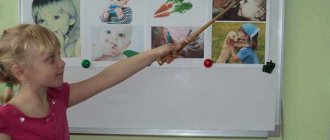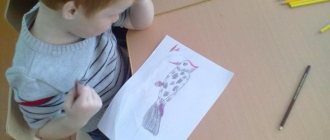Speech therapy exercises for children 2-3 years old
In the second or third year, you can do special speech therapy exercises with your child at home. They develop movements of the lips, tongue and lower jaw. They help strengthen the muscles of the articulatory organs, due to which the appearance of sounds occurs faster. All exercises are performed in front of a mirror.
You can do the following tasks at home:
- bursting of the bubble: the cheeks are inflated as much as possible. Press your palm first on one cheek and then on the other;
- wide smile: lips are drawn out, then you need to smile widely, showing your teeth;
- show your tongue: you need to quickly stick out your tongue and then remove it.
Speech therapy songs for children 2-3 years old
Speech therapy songs for children 2-3 years old are aimed at automating sounds and clarity of speech. The lyrics and notes of the songs interest children and create a joyful and favorable mood for them. The baby sings along with pleasure, and the activity takes on a cheerful and unobtrusive atmosphere. To conduct classes at home, just download online collections of songs from the Internet.
Innovative speech therapy technologies: syncwine
8.Who does what? (use of photographs)
Goal: clarification and expansion of the passive verbal dictionary of children. Materials: To play this game, you need to ask parents to take photographs in which the child performs various actions (see dictionary). How to play: Children love to look at photographs of themselves. It is useful to use this in speech therapy classes. This game is initially played individually, using photographs of the child. At first, you can use only part of the photos. Gradually, as you master the material, add the rest. Place the photos in front of your child. Look, these are your photos. Here is Vanechka. And here is Vanechka. In every photo you do something interesting. Show me where you are sitting. Where do you eat? Where do you swim? Etc. In the future, you can play this game in a group. To do this, you should use photographs of different children selectively so that one action is not repeated twice in the photographs. Look, these are your photos. What are you doing? Find and show who is sleeping. That's right, Tanya. Who combs his hair? Sasha. Who's running? Olya is running. Etc. In the same way, you can conduct classes using photographs of the child’s loved ones performing various actions (see dictionary). This work is carried out individually. Show me where mom washes the dishes. Show me a photo of dad hammering a nail. Show me where my brother draws. Etc.
6. Follow commands!
Goal: clarification and expansion of the passive verbal dictionary of children. How to play: The game is played on the carpet. Place children at a sufficient distance so that they do not interfere with each other's movements. Stand in front of the children. Let's play this game: I will give commands, and you carry them out. Listen carefully and make no mistakes! Let's start! Go. Stop. Raise your hands up. Put your hands down. Sit down. Stand up. Jump. Run. Clap. Stomp. Place your hands on your belt. Etc. In this game, you can use simple movements familiar to children, which were practiced in an imitative game, when the teacher named and performed the movement, and the children repeated after him. The teacher monitors the children’s movements and corrects mistakes.
7.What is the little man doing?
Goal: clarification and expansion of the passive verbal dictionary of children. Materials: a set of pictures depicting various actions according to the number of children. How to play: Before starting the game, give the children one picture each. Look, in your pictures there are boys and girls doing something. Let's play an interesting game. I will make plans for actions, and you listen carefully. Let the one who has a suitable picture raise his hand. Who's sitting? Who's standing? Who's lying? Who's riding? Who's eating? Who drinks? Who is jumping? Etc. If kids find it difficult to answer, you can give a hint by expanding the instructions. To do this, add a description of the items that are in the picture. Who eats the apple? Who swings on the swing? Who is sitting on the chair? And so on.
How to develop speech up to 3 years. Expert advice
To form a speech, you should adhere to the following recommendations from experts:
- Play is very important for proper speech development. With its help, the baby learns about the world around him;
- must be read daily;
- you need to listen to the baby very carefully;
- It’s worth explaining your thoughts to the baby, reasoning with him, talking through plans for the future;
- the child needs to be asked questions that will encourage him to think;
- You need to discuss with your child how he spent his day in kindergarten;
- It’s worth practicing using images;
- The baby must always be supported, even if he doesn’t quite succeed.
Speech therapy chants for children 2-3 years old
Speech therapy for children aged 2-3 years is one of the main methods of working with children who have speech problems. During the work, exercises are used that were developed by Novikova-Ivantsova. Children more easily perceive phrases spoken in rhyme. Music has a beneficial effect on the psychological state of the baby. Together, this increases the effectiveness of the exercises.
The work is based on the ontogonistic principle. For those children whose vowel pronunciation is impaired, singing forms the correct acoustic image. The classes work on the ability to control the pitch of the voice. Children develop proper breathing when speaking.
Important! When selecting speech material for singing, it is necessary to take into account the age of the baby.
An example of speech therapy chants for 2-3 years:
- ku-ku-ku - the rooster crowed ku-ka-re-ku;
- gu-gu-gu - geese are wandering in the meadow.
10.Where is there a lot and where is there little?
Goal: to teach children to distinguish between the grammatical forms of singular and plural nouns. Materials: subject pictures that depict various objects in quantities of one or many (can be selected from visual material on the development of mathematical concepts). How to play: Place pictures in front of the children. Then give the task. Show me where the butterfly is. Where are the butterflies? Where's the ball? Where are the balls? Where is the flower? Where are the flowers? Etc.





